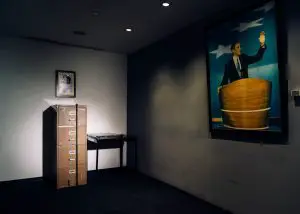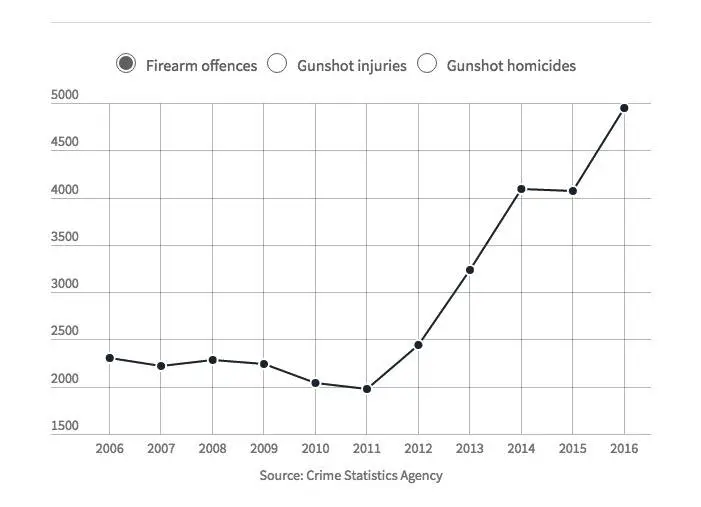Category Archives: Poly-Ticks
 In practically his last minutes in office, political appointee Dan Ashe of the US Fish and Wildlife Service banned ordinary ammunition, not just for hunting but for all purposes including self-defense, on all federal lands.
In practically his last minutes in office, political appointee Dan Ashe of the US Fish and Wildlife Service banned ordinary ammunition, not just for hunting but for all purposes including self-defense, on all federal lands.
Ashe waited until the last minute in hopes that the ban could take hold before his replacement could overturn it. (Ashe knew from the transition team that his services were no longer required, and his last day was 20th January. He has been found a job in a non-profit that does not require him to relocate from his beloved Imperial City of Washington, DC).
The ban, which took effect immediately, eliminates the use of lead-based ammunition on federal lands like national parks and wildlife refuges, as well as any other land administered by the Fish and Wildlife Service. The ban is expected to have a major impact on much of the hunting that takes place on federal lands across the United States as lead-based ammunition is widely legal and used throughout the country.
Ashe said the order was necessary to protect wildlife from exposure to lead.
“Exposure to lead ammunition and fishing tackle has resulted in harmful effects to fish and wildlife species,” Ashe said in his order. “According to the U.S. Geological Survey, lead poisoning is a toxicosis caused by the absorption of hazardous levels of lead in body tissues.”
Boy, are there some bureaucrats who need “a toxicosis caused by the absorption of hazardous levels of lead in body tissues,” or what? But we digress.
Ashe made a sanctimonious attempt to cloak his ban in concern for wildlife.
“Ingested lead pellets from shotgun shells have been a common source of lead poisoning in birds… The use of lead ammunition …[presents] an ongoing risk to upland or terrestrial migratory birds and other species that ingest spent shot directly from the ground or as a result of predating or scavenging carcasses that have been killed with lead ammunition and left in the field.”
via Obama Official Issues Ammunition Ban for Federal Lands on Last Day.
Unlike many Fish & Wildlife Service officials, who tend to be sportsmen from rural America, Ashe is a second-generation career bureaucrat who has never in his adult life lived outside of the National Capital Area and never held a job in the productive sector of the economy (He still hasn’t, in his new capacity as the head of the Association of Zoos, etc.)
Ashe’s 19 January order lasted all the way until 5 March… because the Senate took its time confirming current Secretary of the Interior Ryan Zinke. Zinke, who rocked the Washington press corps, not to mention the Interior bureaucracy, by riding a horse to his office on his first day, hit the Ashe ban like a .600 Nitro Express:
Ryan Zinke’s first act on his first day as interior secretary was shooting down an order signed two months ago that banned use of lead ammunition on federal land managed by the U.S. Fish and Wildlife Service.
Zinke’s order revoked a previous order requiring use of nontoxic ammunition and fishing tackle signed Jan. 19 by outgoing FWS Director Dan Ashe that had been criticized by some hunting and angling groups.
Zinke also signed a second order directing bureaus and agencies managing all federal land to immediately identify areas where recreation and fishing can be expanded.
Over the past eight years, Zinke said, there’s been a decrease in access to public land.
Of course, that access loss has come about at the hands of urban bureaucrats like Dan Ashe.
The horse thing matters, and the symbology is deeper than you think. Like the DC press corps, most of the employees of the Department of the Interior and the Fish and Wildlife Service can’t ride a horse, and would look silly trying to mount one. Hell, most of them can’t drive a stick shift — but they know their way around the Washington Metro.
When Theodore Roosevelt created National Parks as a thing, he never imagined enormous Washington bureaucracies exerting dictatorial power over the outdoors, but staffed almost entirely by strangers to the outdoors.
Even a hagiographic press release lauding Ashe in expectation of his departure scrambles to find actual accomplishments in his nearly six years as FWS supremo. In the end, they came up with: he was good at growing the bureaucracy and expanding quotas for racial minority hiring, and was good at opposing protests on Federal land, when he didn’t agree with the protesters.
ATF Headquarters Ran Fraud to Fund Undercovers
 Unable to spend appropriated funds on some agency priorities, agents ran an operation, under direct verbal control of headquarters, to sell off stolen property (cigarettes and tobacco). They didn’t do this as a smuggling sting as they have done before, but to raise money secretly for further clandestine, off-the-books and outside-the-law operations. The New York Times received the leak (probably as a result of the Mob War of Succession between the Ron Turk and Tom Brandon “families” in ATF HQ):
Unable to spend appropriated funds on some agency priorities, agents ran an operation, under direct verbal control of headquarters, to sell off stolen property (cigarettes and tobacco). They didn’t do this as a smuggling sting as they have done before, but to raise money secretly for further clandestine, off-the-books and outside-the-law operations. The New York Times received the leak (probably as a result of the Mob War of Succession between the Ron Turk and Tom Brandon “families” in ATF HQ):
How that arrangement began is unclear. Ryan Kaye, an A.T.F. supervisor, testified that the [slush fund] was created “as a result of verbal directives from the A.T.F. program office and other headquarters officials.” Mr. Kaye’s full statement is sealed, but excerpts are cited in one publicly available document.
Verbal directives, i.e. “commit nothing to writing,” are not a standard or remotely legal way of doing any undercover operation. They are, in fact, a crime.
We smell the Chief Counsel’s Office, ATF’s equivalent of the Ninth Ring of Perdition. The only other ATF agent publicly identified as involved in the years-long fraud is one Thomas Lesnak, since retired, but dozens of ATF officials seem to have been involved — and, possibly, to have profited.
The operation came to light because the ATF and its informants cheated a group of tobacco farmers out of $24 million, for which the victims are now suing. At least $1M of the farmers’ money was skimmed by the ATF on behalf of each of two of the ATF’s paid informants, Jason Carpenter and Christopher Small. The whereabouts of the other $22 million are unknown at this time — spent on undercover operations, pocketed by agents or supervisors, or some combination of the above, most likely.
The Obama Justice Department fought a battle to keep the corruption trial out of the press, and until something happened in January, the New York Times went along.
It gets better… the government denies all wrongdoing, and have gotten a rubber-spined judge to seal nearly all documents in the case. But somehow the IRS has decided that they ought to make an example of the cheated farmers in this case: by demanding they pay taxes on the money the ATF stole from them. Read The Whole Thing™.
It seems like this is a case made for the appointment of a Special Prosecutor.
Poly-Ticks: Constitutional Carry Update
Here’s an interesting prognosis for Constitutional Carry through 2021 by Charles CW Cooke of National Review.
Cooke believes that “Its popularity keeps spreading inexorably across the country,” and sees the number of states requiring no permit for all or most of the state reaching 15 to 17 this year, based on research by the Crime Prevention Research Center (CPRC). First, let’s look at where it’s law right now:
Cooke’s map of Lott’s read of Constitutional Carry, as of Jan 2017. Light green is CC that is limited in some way. So far, the media-predicted bloodbath in these states has yet to eventuate.
Their list of participants to date numbers 12, a few of which you might quibble about the definitions they’re using.
| State | Effective date |
| Vermont | Since they became a state |
| Montana (99.4% of state) | September 15, 1991 |
| Alaska | September 9, 2003 |
| Arizona | July 29, 2010 |
| Wyoming | July 1, 2011 |
| Arkansas | August 16, 2013 |
| Kansas | July 1, 2015 |
| Mississippi | July 1, 2015 |
| Maine | October 15, 2015 |
| West Virginia | May 26, 2016 |
| Idaho | July 1, 2016 |
| Missouri | January 1, 2017 |
For example, the nonpermissive 0.6% of Montana includes the incorporated city limits — all of them. And Wyoming only extends the right to state residents, not visitors or passers-through. But consider this list in the light of a paragraph from Cooke:
15 years ago there was only one (two if you count Montana, which I’d classify as a “mostly constitutional carry” state) — and that 30 years ago most states had extremely restrictive permitting processes to boot — this is nothing short of remarkable.
Three states were added last year (the bottom three in the table above, from John Lott. FIve more states are likely to be added this year: IN, KY, NH, ND, SD. Four more are prohibitive longshots (CO, MN, TX, UT) where, according to the CPRC’s John Lott, legislatures are unlikely to pass or governors likely to veto, as the governor in Utah already has done; but it’s in play in those legislatures, (Consider the example of NH, where it passed twice and was vetoed twice, but now progresses through the legislature under the gaze of a supportive governor).
Cooke’s Map of Lott’s probable status quo as of one year from now, Jan 2018.
There is a network effect going on here, because in each state, liberals, most Democrats, and the media have bitterly opposed these laws and have predicted bloodbaths, while the actual law has come and gone without any remarkable event. (You might say that Constitutional Carry extends to the citizen inclined to obedience to law and authority the same carry rights that criminals everywhere are already expected to be practicing).
Given that network effect, Lott and Cooke project that several states where pro-gun attitudes among the public are motivating pro-gun attitudes in Congress, will likely go CC in the next four years, i.e., by 2021.

Cooke’s map of Lott’s projection for 2021. For comparison, in 1990 only Vermont would have been shaded.
This movement started slow, but has been accelerating of late. Lott’s prediction is conservative in that it predicts no further acceleration. In addition to the benefits offered to residents of and visitors to permitless carry states, the probable passage of license full faith and credit recognition would draw the fangs of some of the most rabid antigun districts.
ATF Cracks Down on Retro Builders using 80% Receivers
In an entirely unexpected turn of events, ATF has reclassified completed and even so-called “80% lowers” with a fake auto sear marking as machine guns, depending on who makes them. Here’s an image of one such receiver the Bureau has taken custody of and ordered destroyed.
The problem is that fake sear hole. Marking such a receiver with a small, engraved ring has been one detail adopted by detail-obsessed retro builders for years. The receiver above is a typical example of this detail obsession. It began as a so-called 80% blank, and has been completed to firearm stage. But it also has been engraved with Colt markings and extensively machined to change its profile from the current reinforced lower to the M16A1 vintage shape, especially in the vicinity of the pivot pin bosses and the buffer tower. Internally, the receiver remains AR-15 semi-auto profile only, and cannot accept M16 full-automatic parts.
Under this novel, stretching interpretation, this 80% receiver blank, too, is probably a machine gun, even though it is not completed. No trigger group machining has been done, and it cannot accept machine gun (or any) trigger group parts.
There is no consistency to these rulings, and ATF lawyers insist that every ruling applies only to the single case at hand, which must be considered de novo, and that previous rulings are not precedent or even evidence. ATF lawyers will take you to court, and will fight to keep their own agency’s prior determinations out of that court.
The ATF has even given written approval to this engraving — when it’s done by large licensees who can afford lawyers to haggle over ATF rulings, like Colt and Troy:
(Troy has taken hits from the market before for hiring a disgraced ATF figure, and some infer an unusually cordial relationship with ATF management. The Troy receiver also has a couple of unique features, which are discussed below).
ATF has also approved the marking in the past, in letters to individuals and licensees, when it is out of position relative to the factory location of an auto sear. But the same engraving now, and done by or for a little guy who has no practical defense against an ATF attack? Strengstens verboten.
When the definition of an object depends not on what it is, but on who you are, is it really law we’re talking about, or just power? Are we operating under a system of laws that claims derivation from the US Constitution, or under Hammurabi’s Code, which provided “different spanks for different ranks”?
This whole affair began during a routine inspection of US Anodizing in Virginia. All licensees accept such inspections, during which ATF inspectors or occasionally agents examine paperwork, inventory, and overall regulation compliance. Generally these are cordial and professional, but given the weak firearms knowledge of many ATF personnel, and its politics-first pursuit of gun control enthusiast personnel, sometimes they lead to disagreements or disputes. (And some licensees screw up; nothing thrills the ATF more than the chance to hammer a licensee, the bigger the better). On this particular inspection, there was no tension and no suggestion that US Anodizing was doing anything wrong, but ATF initially set several lowers in-process aside for further review. The inspector made a tentative determination that lowers completed from so-called 80% lowers, and showing any indication of a mock auto-sear pin anywhere on the side of the trigger group, was a “machine gun” because it would be “readily convertible.” That’s even in the case of a firearm that would require considerable internal machining to accept MG parts.
There were relatively few receivers — more than three but not more than six — with such a marking on site, but others may have passed through in the past, given this feature’s popularity with retro-heads.
The ATF actually hasn’t seized the receivers in legal terms. Instead, it is holding the receivers and has demanded that the owners voluntarily surrender them to be destroyed, or face prosecution. They say that this is a generous offer that they don’t have to make but are willing to do because they have determined that there was no intent to violate the law.
UPDATE: The following was received from the owner of the 1st receiver illustrated above:
The 1st pic is of my receiver. I am one of the 6 or so that have had my receiver seized. I must tell you that this part :
But, and here’s the rub, they’re demanding that the owners not only allow the ATF destroy the receivers, but also, that they sign a sort of Chinese-show-trial-confession letter, admitting having produced an “unregistered machine gun.”
…is not true. I, at least , have only been given an ATF Form 3400.1. I have NOT been asked to sign anything admitting to creating anything or breaking any laws.
We stand corrected and have lined out the paragraph in question. Form 3400.1, Property Taken into Bureau Custody, is used in nonjudicial takings. It describes the property, and the person or entity from which the property was taken, but does not require or expect any admission of anything. This OIG report of some of ATF’s problems (.pdf) managing seized property in the 2004-05 period shines some light on the regulation in question, ATF 3400.1B. ATF takes approximately 200,000-300,000 items a year, of which about 10,000 to 30,000 have historically been firearms.
The owner of the receiver in the first illustration above decided to sign the ATF letter and let his “machine gun” be destroyed; others, who are not in the crosshairs of the ATF like he is, have criticized him for “caving,” but his choices are (1) give the ATF the uncontested, nonjudicial surrender-of-property that they want, or (2) fight, with the possible outcomes of: (2a) a pyrrhic “victory” that would leave him a financial ruin after years of stress; or, (2b) a decade of two in Club Fed.
Of course, given the legal constraints and historically demonstrated character of the ATF as an institution, you can choose (1) and get (2a or 2b) also, if they feel like making an example of you. Today. For something they approved for Harry yesterday and will approve for Tom tomorrow.
It is hard to fight this kind of creeping, arbitrary, whimsical regulation. Under most US regulatory law, the courts defer almost absolutely to the regulatory agency. As we understand it, and we’re not lawyers, court precedents rule that the expertise on any particular regulatory area is contained within the regulating agency.
There are social and organizational dynamics at work in the current regulatory environment. Once a field agent or inspector makes such a allegation, it’s the instinct of the Firearms Technology Branch to produce whatever it takes to support the ATF officer and keep him or her from losing face, even at the cost of the FTB’s and the Bureau’s reputation for consistency and even integrity.
ATF argues that Colt and Troy are doing something slightly different. For example, Troy’s receiver has a bridge between left and right sides, and is engraved REPLICA – SEMI ONLY for those law officers not steeped in firearms design and construction. But the real underlying problem is baked into regulatory law: there’s no reason that ATF can’t argue the law any of several different ways in different cases at the same time.
We see this ATF power grab casting a chill over the retro movement, which is a small and relatively inconsequential. But the bureau’s real target is the “80% lower” builder in general and the entire home gun building movement, which senior managers and the Chief Counsel’s Office would like to criminalize. This is one of the things that senior managers such as Thomas F. Brandon, who put the ATF behind the Hillary Clinton campaign in major newspapers, was hoping to get out of the Administration they wanted. (Wanted and expected. They had initiatives ready to go).
This is a legal minefield and anyone in this position needs a professional and experienced attorney (i.e. experienced with the ATF and with Federal gun laws).
Going Out with a Whimper
Let’s play Jux Ta Position! That fun game in which we take several news stories and put them together, and see what brilliant insights emerge. Shall we?
First contestant: President Barack H. Obama.
In the world of press releases and the media that dutifully rephrase them, a war leader whose legend eclipses Alexander is hanging up his sarissa, with no more worlds to conquer after eight years of effortless triumph.
DOD Zero-Integrity Flack Lisa Ferdinando has a hilariously, near-North-Korean fawning piece on an official website, where she carefully transcribes the lofty praises the palace eunuchs raise over the great and wondrous works of our own Kim Jong Supreme Personality of Godhead:
Other notable achievements as listed by Carter include the rebalance to the Asia-Pacific region, standing with NATO allies to lead a united response to deter Russian aggression, and securing an accord that is preventing Iran from acquiring a nuclear weapon.
With any luck, she’ll be swept out with the rest of the political appointees in two weeks.
There is no Second Contestant, as the First Contestant has consumed all the oxygen in the room.
Interesting fact: First female Marine Grunts report for duty!
After eight years of command-influenced squeeze, here come three drops of juice.
All three of the infantry Marines graduated from the School of Infantry as part of the service’s gender integration research, said Marine Corps spokesman Capt. Philip Kulczewski.
“The Corps applauds the time and efforts of those Marines who volunteered,” Kulczewski said. “As we continue to move forward…..”
Defense Secretary Ash] Carter had refused an earlier request by the Corps to keep women out of combat jobs after the service’s gender integration study found that mixed-gender teams did not perform as well as all-male teams and that female Marines were more likely to get injured. ….
Retired Marine Gen. James Mattis, Trump’s nominee for defense secretary, told Military Times in September that “shortsighted social programs” could make the U.S. military less effective.
You mean, like the Marines’ own study. Heresy! Burn him!
The three women are one rifle, um, operator; one machine gun crew, uh, member; and one, er, mortar person. Several female officers have been placed in the battalion to act as zampolits for the three Unique and Special Snowflakes™.
First Contestant responds: Women are as Strong as Men!
The outgoing First Contestant knows all he needs to know about the military.
“Joe Biden and I know that women are as least as strong as men,” he said.
He’s probably projecting from his own experience. Michelle looks like she could snap his spine, but doesn’t need to, because just a scowl makes him cry and fold. (The mullahs and Putin had the same experience with him).
During his speech, Obama called the American armed forces the greatest fighting force in the world,,,
Why?
…and celebrated its new found committment to diversity.
Oh, that.
He explained that the new social changes were part of the reason why the military was one of America’s most respected institutions….
Of course, because what everyone wants the military to do is be a global leader in Social Justice. “Sir, our mission is to fly anywhere in the world on 24 hours’ notice to provide an example of diverse vibrancy and genderfluid postmodernism, on direction of the National Command Authority.”
No, no, that just sounds like laughter, it’s how terrorists quake in their boots. Honest, a spokesman said.
And As Deserved as the Nobel Peace Prize
The First Contestant then declared himself the winner, and awarded himself a medal. No, we are not making that up.
Technically, sure, Ash Carter awarded him the medal, as you see in the image; and in addition, it seems to have become a pro forma end-of-tour award for Presidents. But still, it reeks of caudillismo, and Obama shouldn’t have done it, and Bush before him, and anybody else, shouldn’t have done it, either. You’re the President of the United States, for Pete’s sake. Even the freshest private knows that it’s unseemly and just not done to give yourself medals.
And yes, having a fawning toady give you the medal counts as giving yourself a medal. If President Obama ever turned a corner abruptly, Secretary Carter would suffer a broken nose.
One wonders what Carter, whose carambolage of inept improvisation has given MacNamara’s legacy a run for the money, awarded his own self.
Thomas Lifson at American Thinker noticed something about the ceremony:
The ceremony took place at Joint Base Myers-Henderson, before a crowd that had an awful lot of empty seats, almost as if the military service members who attended were there on orders.
No, honest, a private or corporal loves nothing more than to be used as a prop by some politician. “Make sure the ones in the background have plenty of minorities!” We’ve gotta have “college-brochure-picture diversity,” because Diversity is Our Vibrancy™.
How’s Gun Confiscation Working Out in Oz?
Well, in 1996, Australia outlawed and confiscated semi-auto and slide-action rifles and shotguns. And crime in Oz came to a standstill.
We kid, we kid.
After giving the law ten years to stabilize things, here’s what a chart of the last ten years’ gun violations in the city of Melbourne looks like:
Despite Australia’s strict gun control regime, criminals are now better armed than at any time since [the 1996 ban and confiscation].
“Despite.” Heh. Whom do they think benefits most from prohibition of anything?
Shootings have become almost a weekly occurrence, with more than 125 people, mostly young men, wounded in the past five years.
While the body count was higher during Melbourne’s ‘Underbelly War’ (1999-2005), more people have been seriously maimed in the recent spate of shootings and reprisals.
More woundings, fewer fatalities? That tells us this: Australian doctors, nurses, and emergency trauma responders, too, practice continuing education, attend international trauma conferences, and keep improving their skills. (Of course, experience in all those GSWs helps in and of itself). Who knew?
Crimes associated with firearm possession have also more than doubled, driven by the easy availability of handguns, semi-automatic rifles, shotguns and, increasingly, machine guns, that are smuggled into the country or stolen from licensed owners
Did you catch that: “increasingly, machine guns”? Gee, there’s another surprise: you make it just as impossible as you can for someone to own a modern handgun or rifle, and he’s going to think. “As well hung for a sheep as a lamb,” and go for the MG. Not to mention that it is easier for a maker of improvised weapons to make an open-bolt full-auto SMG than it is to fashion a closed-bolt, functioning-disconnector semi-auto firearm. One is reminded of Oleg Volk’s classic photo commentary on this:
Indeed.
The Age found certain troubling factors indicating that the South Australian city was not the glowing example of peace, love and brotherhood that Australian politicians promised when they warmed up the smelters in ’96.
- There have been at least 99 shootings in the past 20 months – more than one incident a week since January 2015
- Known criminals were caught with firearms 755 times last year, compared to 143 times in 2011
- Criminals are using gunshot wounds to the arms and legs as warnings to pay debts
- Assault rifles and handguns are being smuggled into Australia via shipments of electronics and metal parts.
Of course, 99 shootings is a bad summer weekend in Chicago, but we do feel Australia’s pain.
As we have seen repeatedly, laws restrict only the honest people. The criminals, who cheerfully move millions of tons illegal freight, whole warehouses of contraband, and entire armies of personnel, criminal immigrants and trafficking victims alike, worldwide, are not finding it too much of a challenge, to move some 8-pound rifles and 2-pound pistols.
The Bronze’s answer? More laws against more stuff, because people are not impressed by the extant skein of laws.
[T]he state government is planning to introduce new criminal offences for drive-by shootings, manufacturing of firearms with new technologies such as 3D printers, and more police powers to keep weapons out of the hands of known criminals.
Now, the State Government of South Australia is a matter for the South Australians themselves, and not to be made idle sport of by distant Yanks, but we do seem to remember it is the very same government whose brilliant energy policy, based upon wind power, recently left the citizens without electricity for days on end, due to the fickle winds not responding to the magical incantations of the SA politicians. No doubt they will pass some law against the wind, or perhaps the want of wind, and it shall have as much effect as these well-meant but ill-considered gun laws.
And then there’s this finding:
The majority of firearm-related crimes are committed by those aged 20 to 34 – almost 1500 offenders were recorded for this age group last year, more than two-and-a-half times the number five years ago, according to the Crime Statistics Agency.
Gee, most criminals are young men. Who knew? We mean, aside from every criminological text, study and paper ever penned since the monographs of Sherlock Holmes. (In fact, a disproportionate percentage are young minority men, but The Age is a bit too PC to follow that thread). It never ceases to amaze us that reporters will still write about a discovery like this as if it were news. In other news, studies have determined that the majority of water is wet.
The part about smuggling is worth quoting at length. First, they try to blame legitimate owners:
2014, Australia reached a disturbing milestone – the moment when there were more legally-owned firearms in the country than before the 1996 Port Arthur Massacre.
The national gun buyback scheme launched by then Prime Minister John Howard led to the voluntary surrender of more than 700,000 firearms, but more than a million new weapons have been legally imported since.
But then they admit that the problem may lie elsewhere.
But the “diversion” of newly imported weapons – either through theft or illegal sale – is one of the biggest sources of black-market firearms, a senior law enforcement source says.
Despite Australia’s strict border controls, the smuggling of high-powered military-style firearms is also a growing problem, particularly with the country’s reliance on shipping by sea cargo and the rise of the so-called “dark web”.
Australia is a nation with no land borders anywhere, and no significant domestic firearms industry. If gun control was going to work anywhere, it would work here.
The investigation of an armed robbery of an armoured car outside a Sunbury McDonald’s last year revealed the arsenal of powerful weapons now in the hands of local criminals.
Victoria Police raids on the crew allegedly responsible for the $290,000 theft uncovered a cache of military-style weapons, including a US-made M16 assault rifle and a Thureon machine gun – a firearm never before seen in Australia. Thureons would be used in other crimes over the next year.
That bust led to the seizure of six fully-automatic assault rifles and 96 handgun frames in the US, and dozens of machine gun and handgun parts, and 10 kilograms of ammunition, in Victoria and NSW.
The raids came from the formation of a special state, national and international task force known as Operation Ironsight.
Police admitted they had only recovered four of the 11 assault rifles believed to have been smuggled into the country.
The weapons that were seized in the US were set to be smuggled into Australia in the false bottom of a shipping container. Gun components can be extremely difficult to detect when mixed with metal objects or car parts, sources say.
Given that only a fraction of sea cargo can be physically examined at the point of import, law enforcement and border authorities are deeply concerned about the vulnerability of Australia’s docks and freight terminals.
Joint operations between the AFP and Bureau of Alcohol, Tobacco and Firearms have also intercepted a high-powered handgun concealed inside an Xbox console and parts for an assault rifle hidden in a DVD player. Both were ordered by Australians through a black market website and shipped by post from the southern United States.
Why do criminals risk prison to smuggle these goods? We would say, based on our studies of insurgency logistics (which have some similarities to criminal organization logistics), that there are several factors.
- They are highly motivated to acquire firearms;
- Smuggling is usually effective. Most smuggled goods get through (drug agencies have long suggested 90%) and many, if not most, smugglers are never caught;
- Rewards are immediate, certain, and significant. Punishment is delayed, uncertain, and often less significant (in the value system of a criminal);
- A low level of smuggling suffices;
- The flow of cargo can’t be interrupted and can’t be inspected, only spot-checked or inspected in the event of a tip-off or surveillance-driven break;
However firearms get onto the black market, the trade can prove very lucrative for the organised crime groups that control it.
A brand-new Glock semi-automatic pistol purchased for $700 from a legal firearms dealer in the United States will fetch $8000 to $12,000 on the streets of Melbourne.
The economics of clandestine production are similarly attractive, of course. And the more pressure the police apply, the better the economics get, for the 90% (or whatever the number actually is) of criminals that do not get caught.
Ten or twenty years from now, most Australians will not be committing crimes, and a small minority of Australians will, just like any other nation. And in neither case will the Australian gun laws be a major factor.
Cyber: the DNC Hack

The DNC maintains a creepily-lighted shrine with their locked Watergate file cabinet and their unsecured, formerly internet-connected server. Not the same thing, genius.
There’s been a lot of noise about the Russians and the DNC hack — mostly, it’s Democrats and the press (but we repeat ourselves) trying to delegitimize the incoming administration, and mostly, it’s been conducted through the F-6 sources of press reports with anonymous sole sources, like the Washington Post report that the Post and its political fellow travelers call “the CIA report,” while actually it’s a sole anonymous source telling the Post what the CIA supposedly said. (The Post, you may remember, used a [probably nonexistent] sole anonymous source, without plausible access to tell the story of “Jessica Lynch, Amazon woman.” The author of that piece, Dana Priest, has never admitted fabricating the story but never produced a source, either, leading to the inescapable conclusion that Priest fabricated the story. She has never been held accountable).
An interesting dynamic happened in 2015. The FBI warned both parties that they were under attack. According to then-RNC head Reince Priebus on Meet The Democratic Press, the RNC then invited the FBI to work with its own geeks to secure the RNC servers, and the Republicans were not hacked.
According to the Times, the Democrats dumped the FBI call to a low-ranking, unskilled contractor — then they left him on his own to handle it. They left their server unsecure. Result, compromise.
When Special Agent Adrian Hawkins of the Federal Bureau of Investigation called the Democratic National Committee in September 2015 to pass along some troubling news about its computer network, he was transferred, naturally, to the help desk.
His message was brief, if alarming. At least one computer system belonging to the D.N.C. had been compromised by hackers federal investigators had named “the Dukes,” a cyberespionage team linked to the Russian government.
Yared Tamene, the tech-support contractor at the D.N.C. who fielded the call, was no expert in cyberattacks.
OK, so what did he do, like a good DC Millennial? You got it, he googled, and then resumed slacking off.
His first moves were to check Google for “the Dukes” and conduct a cursory search of the D.N.C. computer system logs to look for hints of such a cyberintrusion.
No, serious slacking off.
By his own account, he did not look too hard even after Special Agent Hawkins called back repeatedly over the next several weeks — in part because he wasn’t certain the caller was a real F.B.I. agent and not an impostor.
“Like, how do I, like, know you’re a like real FBI agent, doooood? Thats what I tell girls in bars myself.” Again, this loser is supposedly their cyber-D contractor. You know how to find out if somebody’s really from FBI? Ask for a meeting at the Field Office. Hey, even if you’re a plush-bottomed cyber Weeble unwilling to leave your Aeron chair, you can ask them to send you something from fbi.gov, and then check the headers to see if the address is forged. (If you don’t know how to forge a header and how to spot a forged header, you have no business within grenade range of a mail server).
From there, the Times story collapses into, mostly, the same unsourced stuff in the Post stories. If these guys make something up and repeat it to each other, they call that “corroboration.” That’s not how intelligence works.
It does come back to the tale of the incompetent Tamene and his incompetent 30-something supervisor, Andrew Brown. Tamene ran some over the counter tools — the DNC was not running an IDS, Intrusion Detection System — and thereafter decided that the FBI guy was a phony, lacking Tamene’s great wealth of knowledge, and wrote a couple of CYA memos, and quit taking calls.
Mr. Tamene’s initial scan of the D.N.C. system — using his less-than-optimal tools and incomplete targeting information from the F.B.I. — found nothing. So when Special Agent Hawkins called repeatedly in October, leaving voice mail messages for Mr. Tamene, urging him to call back, “I did not return his calls, as I had nothing to report,” Mr. Tamene explained in his memo.
In November, Special Agent Hawkins called with more ominous news. A D.N.C. computer was “calling home, where home meant Russia,” Mr. Tamene’s memo says, referring to software sending information to Moscow. “SA Hawkins added that the F.B.I. thinks that this calling home behavior could be the result of a state-sponsored attack.”
There are some Democrats quoted by name, generally about the bad feelz that resulted when their misconduct, lying, or biting the hands that fed them got aired in public.
For the people whose emails were stolen, this new form of political sabotage has left a trail of shock and professional damage. Neera Tanden, president of the Center for American Progress and a key Clinton supporter, recalls walking into the busy Clinton transition offices, humiliated to see her face on television screens as punditsdiscussed a leaked email in which she had called Mrs. Clinton’s instincts “suboptimal.”
“It was just a sucker punch to the gut every day,” Ms. Tanden said. “It was the worst professional experience of my life.”
Well, you should probably either work for people you can say positive things about, or take care to stifle your impulses to criticize your lords and masters. Because anything put in writing is at the mercy of anyone who finds it. And anything put on an unsecured server — and from Hawkins’s phone call, the DNC knew they were unsecure, and they kept writing the sort of two-faced stuff they’re now angry about seeing in print.
Bear in mind that no fewer than five New York Times reporters were exposed in Wikileaks, coordinating their stories with the DNC or the Clinton campaign; and one non-Times hack, Glenn Thrush of Politico, who repeatedly gave Democrats the chance to shape his reporting, was hired as a Times hack as of this week. That’s what they’re looking for — partisan subservience. They seem to believe they have a right to collude, lie and slant their stories, and the people who exposed them (even if they’re Russians) are the only villains. Had the US lost the Cold War, every one of those would be licking the boots of their masters in the Soviet Ministry of Propaganda. If they didn’t aim higher than boots. (Hell, those who were old enough to be around pre-1991 probably spent the 70s and 80s doing it already).
Update
A British associate of Julian Assange says that it was not a hack, it was two separate insider leaks. Reported at ZeroHedge:
Update: David Swanson interviewed [Briton Craig] Murray today, and obtained additional information. Specifically, Murray told Swanson that: (1) there were twoAmerican leakers … one for the emails of the Democratic National Committee and one for the emails of top Clinton aide John Podesta; (2) Murray met one of those leakers; and (3) both leakers are American insiders with the NSA and/or the DNC, with no known connections to Russia.
The US Intelligence services consider Assange to be under Russian control, so it’s anybody’s guess whether Murray’s statement is a Russian smokescreen, or absolute truth, and whether or not the leaker(s) exist. The effort to find them itself has risks — an organization can be rendered ineffective completely by a mole hunt. Where does security consciousness end, and paranoia begin? And don’t even paranoids have real enemies.
For your consideration: Russian cyber operators are laughing their asses off at the USA right now — whether or not they had anything to do with the hack, it’s a win for them.
When Congress Used to Vote on Outlawing Handguns
 Antigun sentiment was once even stronger in Congress, and it In 1934, a handgun ban was part of the original draft of the National Firearms Act in Congress, but was dropped by proponents to secure passage of a narrower law restricting only machine guns and short-barreled long guns.
Antigun sentiment was once even stronger in Congress, and it In 1934, a handgun ban was part of the original draft of the National Firearms Act in Congress, but was dropped by proponents to secure passage of a narrower law restricting only machine guns and short-barreled long guns.
By the early 1970s, the ban was back, and was probably at its all time apogee, historically speaking. Anti-gun extremists in both parties supported handgun-ban and ban-enabling registration amendments to a gun-control bill introduced by the extremely anti-gun Senator from Indiana, Birch Bayh (father of the recently defeated candidate for an Indiana seat in the Senate, Evan Bayh, who shares his father’s distaste for guns and gun owners). Edited excerpt of a letter to the editor of Field and Stream, which had endorsed mostly Democrat Senators for re-election on environmentalist grounds. This letter (edited for brevity only) and a defensive-crouch response were published on p. 6 of the November, 1972 issue of the magazine:
Here is the way your outstanding senators voted on three of the amendments… [to] the Bayh gun-control bill:
- Hart amendment to outlaw private possession of handguns: Brooke, Harris, Hart, Kennedy, Ribicoff, Tunney, Williams. … Absent but recorded for: Javits.
- Kennedy amendment to require licensing-registration of all firearms: Anderson, Brooke, Case, Hart, Kennedy, Muskie, Ribicoff, Tunney, Williams… Absent but recorded for: Pell, Javits.
- Stevenson amendment for licensing-registration of handguns: Brooke, Case, Cooper, Hart, Hughes, Javits, Kennedy, Mondale, Muskie, Percy, Ribicoff, Stevenson, Tunney… Absent but recorded for: Pell.
Also: the following voted against the Dominick amendment providing mandatory penalties for gun possession or use during the commission of the felony: Anderson, Cooper, Hart, Hughes, Kennedy, Mathias, Mondale, Muskie, Nelson. These men don’t want to interfere with the criminal, just the law-abiding sportsman.
An editor (presumably Editor Jack Samson) responded defensively that it was “unfortunate” that the Senators who were good on the environment, as he and author Michael Frome defined “good,” were not good on the gun issue, but the gun issue wasn’t important, and maybe you could persuade a Kennedy, Hart or Mondale to change his mind.
Kennedy and Tunney, who later would combine in a secret effort to get Soviet Premier Yuri A. Andropov to sponsor an overthrow of Reagan for Kennedy in the 1984 election (Andropov didn’t snap at the bait), were strangely less comfortable with armed Americans than with Soviet power.
A direct look at Congressional reports available (for instance, here on Google Books) shows that gun bans frequently came up in that period, although they usually died in committee. Here’s that example:
16.S. 2815 introduced November 5, 1971 by Senators Hart and Harris.
To prohibit the importation, manufacture, sale, purchase, receipt, possession, or transportation of handguns, except for or by members of the armed forces, law enforcement officials, and, as authorized by the secretary of the treasury, licensed importers, manufacturers, dealers, antique collectors, and pistol clubs. Legislation pending.
But “Nobody wants to ban guns.” Horsefeathers.
In any event, S. 2815 went the way of all flesh in 1971, in this case, dying in committee. That’s why the above-mentioned Senators frequently brought up the bans as riders to other bills, in other committees. All they needed was, one time, to get enough of a gun control majority to squeeze a ban through, and they could get it on to the floor. At the time, both Houses of Congress were solidly Democratic, but the Democrats were divided between anti-gun Coastals and pro-gunners from rural states, especially in the South.
They thought that if they attached a ban to an important enough bill, there may have been enough liberal coastal Democrats, liberal New England Republicans, and other Democrats vulnerable to party arm-twisting, to pass the ban. But this high-water mark of anti-gun power produced a backlash, uniting pro-gun activists and sportsmen, and earmarking nails for the political coffins of southern Democrats and those rural-state Senators and Congressmen whose real home had become Washington and whose real values were those of aspiring prospective members of the Georgetown set. In the 1970s, Idaho could produce a Frank Church, who was on a mission to destroy the military, the intelligence agencies, and gun rights; in the 21st Century, it’s unlikely.
Nowadays, to sell a ban they have to narrowcast it; to sell registration they have to cloak it as something else, as anti-gun Sens. Schumer, Manchin and Toomey did in their “background checks” backdoor registration bill. (Only Manchin’s and Toomey’s names were on it, but Schumer’s staff wrote it and he was directing Manchin and Toomey in the effort).
 Field and Stream, which surely must have counted Elmer Fudd among its subscribers, came to have second thoughts about its 1972 handgun-ban advocacy (in service of a “greater cause,” of course). By 1976 (May, November) the magazine’s E.B. Mann was writing critically of Kennedy, Hart, Bayh and Tunney and their gun-ban projects. The 1970s were, in retrospect, the high point of the coastal liberal quest to actually ban firearms, and thereafter ban attempts were narrowly focused, using a divide-and-conquer approach (much like the divide-and-conquer approach between handgun users and hunters accepted by Field & Stream in 1972) but targeted narrowly on focus-grouped and rhetoric-tested neologisms: the handgun ban was reborn as “Saturday Night Special” restrictions, long gun bans as “Assault Weapon” or “Sniper Rifle” bans, universal pre-confiscation registration reborn as “Universal Background Checks.” The new approach was predicated on the idea that you can’t recognize a Nazi if you peel off his brown shirt and issue him a personable publicist, and its high-water mark was arguably the now-sunsetted 1994 gun ban.
Field and Stream, which surely must have counted Elmer Fudd among its subscribers, came to have second thoughts about its 1972 handgun-ban advocacy (in service of a “greater cause,” of course). By 1976 (May, November) the magazine’s E.B. Mann was writing critically of Kennedy, Hart, Bayh and Tunney and their gun-ban projects. The 1970s were, in retrospect, the high point of the coastal liberal quest to actually ban firearms, and thereafter ban attempts were narrowly focused, using a divide-and-conquer approach (much like the divide-and-conquer approach between handgun users and hunters accepted by Field & Stream in 1972) but targeted narrowly on focus-grouped and rhetoric-tested neologisms: the handgun ban was reborn as “Saturday Night Special” restrictions, long gun bans as “Assault Weapon” or “Sniper Rifle” bans, universal pre-confiscation registration reborn as “Universal Background Checks.” The new approach was predicated on the idea that you can’t recognize a Nazi if you peel off his brown shirt and issue him a personable publicist, and its high-water mark was arguably the now-sunsetted 1994 gun ban.
Poly-Ticks: Castro’s Record on Guns
 Politics, n. From Greek poly-, “many,” and ticks, “small bloodsucking arthropods.” – Ed.
Politics, n. From Greek poly-, “many,” and ticks, “small bloodsucking arthropods.” – Ed.
First, the good news: Fidel Castro is still dead, getting the guided tour of Hades from Che, and his “revolution,” which yielded a primitive absolute monarchy in all but name, is at death’s door. His elderly, sickly brother is soon to check out himself, and the next generation’s pampered family members being weaker of character than the crowned heads of Europe in 1914, Cuba may soon be a republic in more than just name.
 Second, the bad news: the brothers Castro have no end of admirers in the Western elite, probably for their raw and brutal exercise of power rather than despite it. There are no end of fawning articles, to the point where they make the groveling Justin Trudeau look skeptical; we were reading one about “Fidel Castro and the Jews” that proclaimed him the great protector of Cuba’s Israelite diaspora, despite having driven over 90% of them into exile, the remaining handful into poverty (like everyone else), and sponsoring and arming anti-Israel and anti-Semitic terrorism globally. But the (presumably Jewish) author of the piece seemed to think he was great for the Jews. By that standard, you might as well call Hitler “rabbi.”
Second, the bad news: the brothers Castro have no end of admirers in the Western elite, probably for their raw and brutal exercise of power rather than despite it. There are no end of fawning articles, to the point where they make the groveling Justin Trudeau look skeptical; we were reading one about “Fidel Castro and the Jews” that proclaimed him the great protector of Cuba’s Israelite diaspora, despite having driven over 90% of them into exile, the remaining handful into poverty (like everyone else), and sponsoring and arming anti-Israel and anti-Semitic terrorism globally. But the (presumably Jewish) author of the piece seemed to think he was great for the Jews. By that standard, you might as well call Hitler “rabbi.”
Just ’cause a guy hates Christians, doesn’t mean he’s good for Jews. That’s not how atheistic Communism works, kid.
Anyway, now that we’ve established (or really, a half-century of other, better writers have established) that Castro was bad for believers, unless the godhead they believed in was him, we might as well do like all those Woody Allen type New York nebbishes do, and write about, “Was he good for us?” By “us,” of course, meaning the People of the Gun. And the answer, of course, is, “Hell, no.” Here’s Larry Pratt at GOA, eight years ago (bold is our emphasis):
A look at the history of Cuba should make us run screaming in terror from anything smacking of socialism. Brain surgeon Miguel Faria has laid it all out for those who will check out his book Cuba in Revolution.
Faria is a refugee from Fidel Castro’s socialist “paradise.” He still has family trapped inside that socialist island prison — a prison that has imposed draconian gun controls throughout the island. Any prison will attempt to achieve total control of guns and restrict their possession to just the guards. Well, it turns out that the most effective tool for gun control in Cuba is the poverty spawned by socialism. Nobody can afford a gun.
Communist Cuba offers an interesting parallel to Nazi Germany. Both Hitler’s Germany and Castro’s Cuba were preceded by regimes that imposed gun control to keep guns out of the wrong hands. In both cases, gun control failed to keep the bad guys from getting all the guns they wanted and using them to consolidate their grip on power following seizure of the reins of government.
Hitler took several years to disarm the populationusing gun registration lists, but Castro moved against private gun ownership the second day he was in power. He sent his thugs throughout the island using the gun registry lists — compiled by the preceding Batista regime — to confiscate the people’s firearms. Different tactics, same objective. A defenseless people don’t give the all-wise leader any lip.,
So, perhaps you see American gun controllers as potential Castros, who lust for power. Some of them certainly are (Charles Schumer, come on down!). But many of your opponents in this are people of good will who happen to dislike guns and find blaming the firearm more psychologically comforting than facing the unpleasant fact that real evil walks in the world. It is no accident that there is a strong correlation between gun control and atheism, because true evil is more easily and clearly understood by people with a theistic viewpoint. (That is not to say that all atheists are anti-gun, not by a long shot. A pro-gun position can be reached by pure reason).
But while thinking gun rights supporters believe that opponents may ave committed an error of reasoning, gun rights opponents, often deprived by their atheism of any ability to understand true evil, reach a conclusion that our opposition is somehow the product of paid activity. So professional career left-wing and anti-gun PR executive Shannon Watts, a paid agent of Bloomberg,, often accuses her opponents of being paid by the NRA (dang, where’s my check? I pay them) and the NRA being paid and controlled by the gun manufacturers, because that’s the only way that they can understand people being so “wrong” as we are. Alternatively, they use the rubbery terms of the squishy semi-science of psychology to suggest we’re ill.
It so turns out that, in that, too, the psychological denormalization of dissent, there’s a parallel with Castroism. Pratt again:
Another parallel between Cuba and Nazi Germany is the prostitution of psychiatry. Psychiatrists were willing tools of the Nazi regime to “diagnose” opponents as mentally ill. Cuba is no different. And the mental hospitals are horror chambers where victims of the Castro thugocracy are drugged into submission. Alternately, they are electro shocked into compliance.
Of course, if you’re a religious believer, you probably already are using a handy bin your faith provides — “evil” — to classify folks like the billionaire brothers Castro.
But their motivations matter only to the extent that understanding them is useful for defeating them. Because their defeat is a necessary precondition to the survival and success of that greatest of human conditions, liberty.
¡Viva Libertad! ¡Viva Cuba Libre! ¡Viva Brigada 2506!
The History of a Legal Theory: Right to Bear Arms
 As long-time readers know, we maintained a strict no-politics position for the first year or so of the blog. In the aftermath of a gigantic press by the President/media/billionaire-hireling contingent for more gun bans after the shooting of children by a nut case in Newtown, CT (who had got the guns by murdering his own mother), we’ve backslid on that quite a bit and occasionally let slip pro-gun political commentary. (Here. On Gab we’re politically unrestrained). We frankly prefer not to do it, and instead of talking politics we’d rather be geeking out over historic firearms and obscure events in military history, as well as expressing some SF Pride that has nothing to do with rainbow flags and quarterback manqué Colin Kaepernick on one hand, or grown men who dress up as Klingons or Wookiees on the other. NTTAWWT.
As long-time readers know, we maintained a strict no-politics position for the first year or so of the blog. In the aftermath of a gigantic press by the President/media/billionaire-hireling contingent for more gun bans after the shooting of children by a nut case in Newtown, CT (who had got the guns by murdering his own mother), we’ve backslid on that quite a bit and occasionally let slip pro-gun political commentary. (Here. On Gab we’re politically unrestrained). We frankly prefer not to do it, and instead of talking politics we’d rather be geeking out over historic firearms and obscure events in military history, as well as expressing some SF Pride that has nothing to do with rainbow flags and quarterback manqué Colin Kaepernick on one hand, or grown men who dress up as Klingons or Wookiees on the other. NTTAWWT.
But this article is a bit of political, policy, and legal history. From time to time we marvel at the great strides that gun and self-defense rights in the USA (and, slowly, worldwide) have taken in our own lifetime. As long-term readers know, just 30 years ago most US states were quite restrictive on handgun carry (yes, you couldn’t get a permit in Texas, of all places). Gradually laws liberalized, and states went from can’t carry to can-with-permission-we-might-give-ya to mandatory-permission to, in almost 10 states now, your rights as a free man or women being permission enough. There is more to do, but history is moving in our direction.
History does not move, like an army, on its belly. It moves on ideas, on philosophy, and culture. Before every trend in today’s world, positive, negative or just plain sick, was a trend in the law, it was a trend in the culture, and before that it was an idea — which brings us back to the law. A few years before Florida opened the political movement towards shall-issue permits, it was an idea in the legal academy. Two things published this month should help you understand the genesis and growth of this idea.
The first is this obituary of legal scholar Don Kates, by legal scholar Gene Volokh. If you slipped a gun in your holster this morning, and you are not a servant of the State, you owe a debt to Kates, whether you have heard of him or not. With his passing, many law professors have expressed astonishment that one man could have been so influential in America’s understanding of fundamental laws and principles — when he, himself, was not a law professor. Whether that says more about Kates or about the self-regard of law professors is an exercise we’re pleased to leave to the reader.
The second is Nelson Lund’s analysis of the history of understanding the Second Amendment in the context of exceptional American liberties. It is abstracted on this page at Heritage, where you may also download the whole .pdf (highly in the context of exceptional American liberties.recommended). Proof of Lund’s genius is the degree to which he agrees with us. From the page:
Despite persistent elite enthusiasm for disarmament schemes, both the law and public policy have moved in the opposite direction during recent decades. Two developments stand out.
- In the 1980s, a tiny group of lawyers began to publish scholarly analyses debunking the dismissive interpretation of the Second Amendment that dominated courts in the 20th century. Notably, almost none of this pioneering scholarship was carried out by professional academics in the law schools.[8]
- In 1987, Florida became the first jurisdiction with large urban population centers to enact a statute permitting almost all law-abiding adults to obtain a concealed-carry license. Notwithstanding near-hysterical prophecies from many police chiefs and other putative experts, violent crime went down instead of up, and license holders almost never misused their weapons.[9] Florida’s successful experiment soon spread to other states, and social scientists have yet to find evidence of adverse effects on public safety.[10] It is now harder than it once was to stampede legislatures into enacting feel-good gun-control measures that do nothing to reduce crime.
As Lund makes clear, this whole thing is not inevitable, and it requires continued effort by those supporters of human rights and self-defense in the academy, the culture, politics, and the public to continue to improve this situation. He also illustrates how the homogeneous political elite, the Acela Corridor aristos, of both parties and all political flavors tend to bias against this right. It’s a most worthwhile document; to Lund from Kates’s failing hands falls the torch of liberty, unextinguished.
May it long be a light for the world.

Kevin was a former Special Forces weapons man (MOS 18B, before the 18 series, 11B with Skill Qualification Indicator of S). His focus was on weapons: their history, effects and employment. He started WeaponsMan.com in 2011 and operated it until he passed away in 2017. His work is being preserved here at the request of his family.











